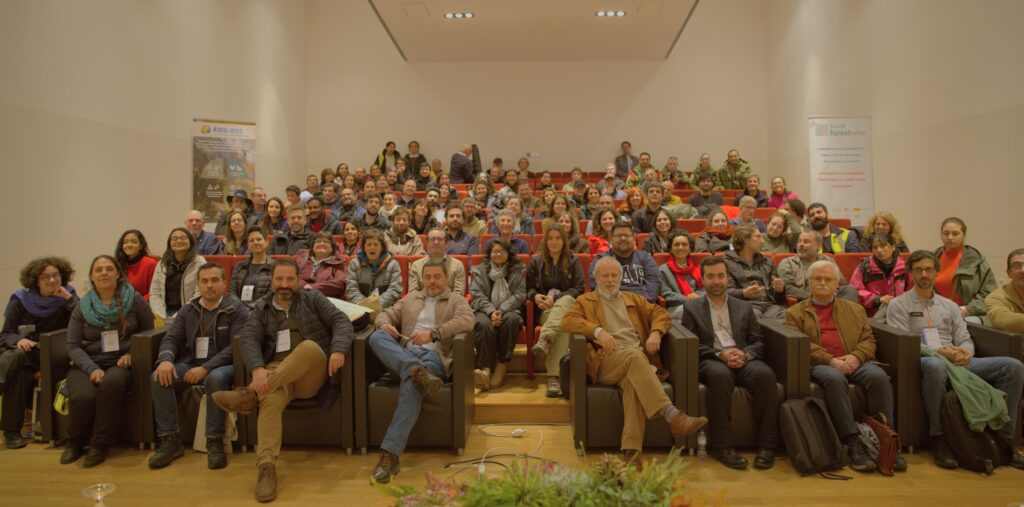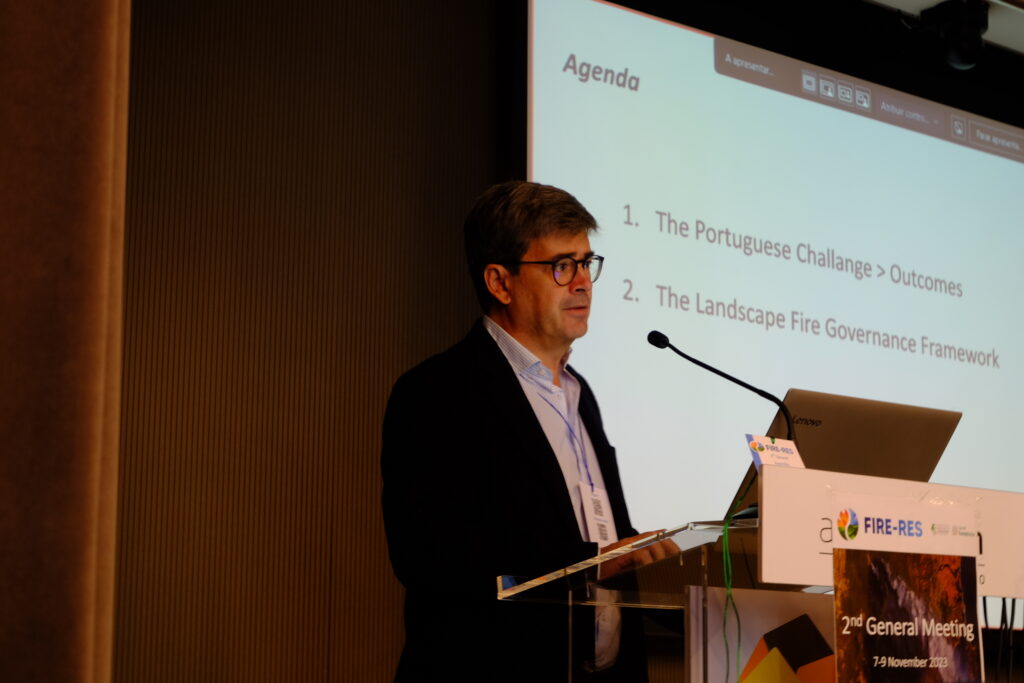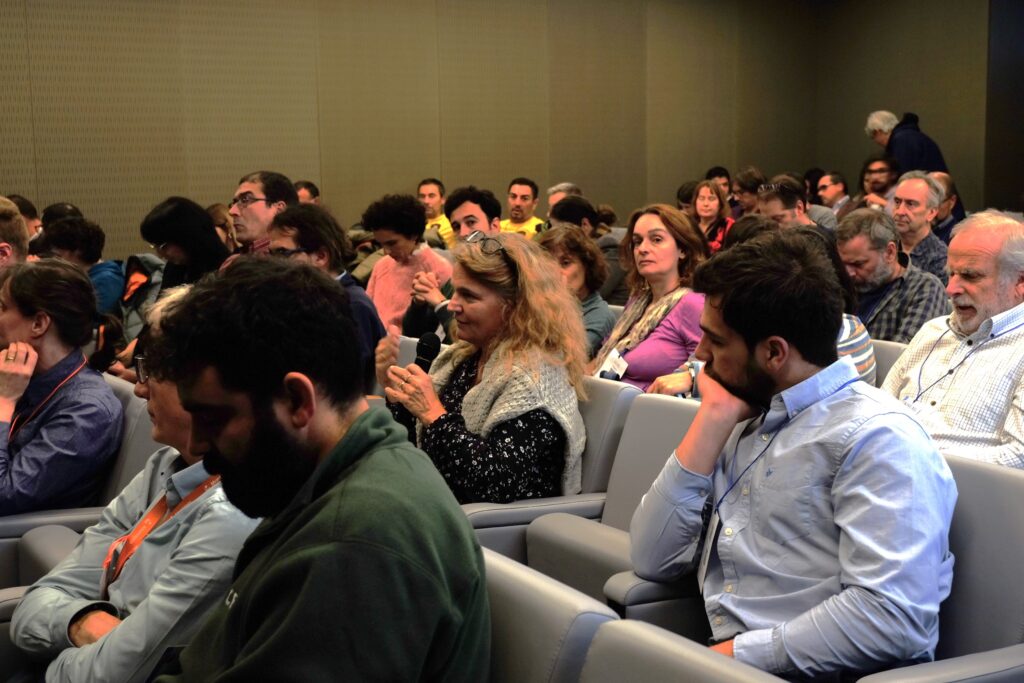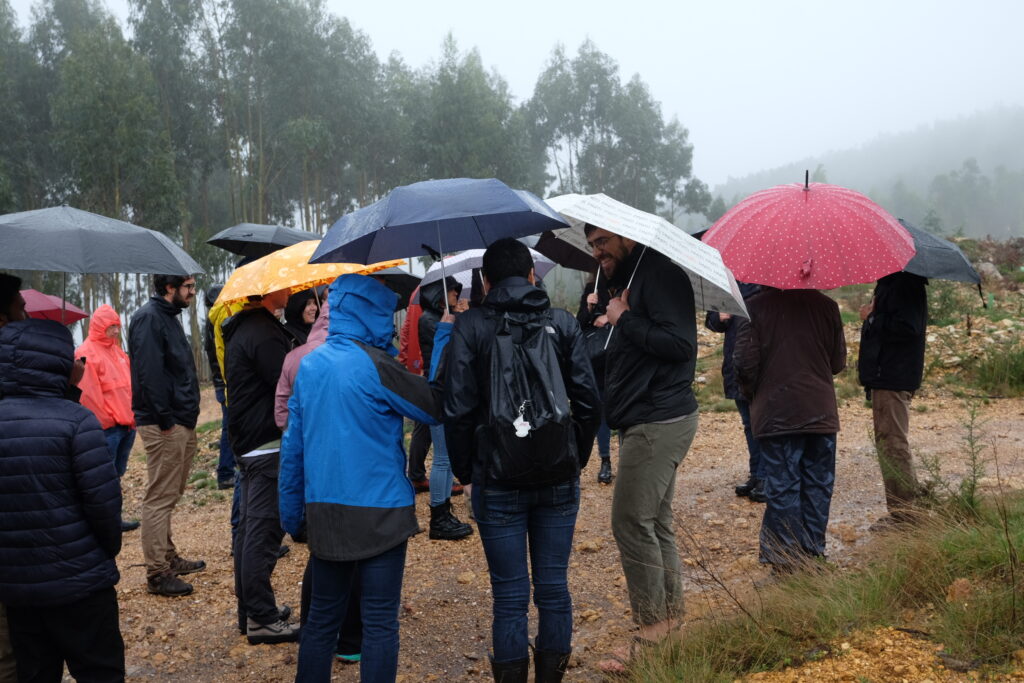The FIRE-RES consortium meets again to take stock of the results achieved so far and prepares for the implementation phase combining the General Assembly with high-level external expert contributions.

Picture by CoLab ForestWISE
FIRE-RES partners and its Advisory Board gathered in Porto (PT) from 7th to 9th November 2023 for the annual project meeting and the second General Assembly. The meeting was hosted by ForestWISE – Collaborative Laboratory for Integrated Forest and Fire Management, the Higher Institute of Agronomy of the University of Lisbon and Vale do Sousa Forestry Association (AFVS). This time, the programme went beyond the regular exchange between work packages, by combining a series of expert talks and field visits to gain insights about the Portuguese Living Lab. The three days successfully integrated into the conversation the local and national voices from Portugal with international insights from outside of Europe.
Day 1
After the institutional welcome with José Borges (ISA), Carlos Fonseca (FWISE), Francisco Castro Rego (ISA) and Sandra Pinto (AFVS), the first day kicked off with insights from the project’s development, including a general overview by the overall coordinator Antoni Trasobares (CTFC), as well as the intervention of FIRE-RES project Officer Nicolás Faivre (European Research Executive Agency).
Later, the focus shifted to external interventions. This session was marked by a line-up of high-level international speakers who shared their diverse expertise, sparking discussion and mutual learning on wildfire-resilient landscapes.
Keynotes kicked off with Tiago Oliveira (AGIF) who gave an overview of the International Landscape Fire Governance Framework, highlighting the future challenges of living with wildfire disasters and managing uncertainties within the policy dialogue. The conversation then focussed on understanding Extreme Wildfires Events and moving towards resilient landscapes: from Zisoula Ntasiou shared insights on the wildfire 2023 season in Greece, Teresa Valor (CTFC) talked the audience through key forest drivers for resistant and resilient landscapes to EWE. Finally, Marc Castellnou (CFRS) stressed the cruciality of pyroconvection adjustments in the decision-making during wildfires.

Picture by Euromontana
The following session was all about designing wildfire-resilient landscapes. Mark Finney (U.S. Department of Agriculture) talked about reducing landscape wildfire risk and acknowledged the impossibility of eliminating risk entirely. He discussed limitations in fuel breaks and complexities in area treatments. Despite efforts, baseline risk will always persist, necessitating public understanding. Finney underscored the importance of considering social consequences in decision-making and urged the use of imperfect but effective solutions, recognizing the cultural and political dimensions of the challenge alongside scientific and technological approaches.
In her intervention, natural resources consultant Ruth Ryan advocated for a wildfire-resilient perspective, emphasizing the value of indigenous knowledge, prescribed burning, and resilient built environments. She underscored the need for strong government commitment, prepared communities, and healthy rural economies for faster recovery. Ryan highlighted the importance of fire prevention, adaptive management, and community trust in defining acceptable risk.

Picture by Euromontana
The following session focussed on the role of education and communication for wildfire-resilient landscapes. Another member of the FIRE-RES advisory board took the floor: Valerie Charlton (Landworks) illustrated the concept of Education, Enforcement, and Engineering. She highlighted the challenge of getting people to recognize the risk, particularly in private owner-responsibility landscapes like South Africa. Scenario planning, effective communication, and harmonizing operations across different landscapes are key. Charlton showcased some creative approaches to risk communication and clarified the role of enforcement in achieving acceptable risk.
The last group of keynotes focused on decision support systems for wildfire-resilient landscapes.
Philip Selegue (CAL FIRE) discussed the operational tools employed by CAL FIRE to manage wildfires effectively, illustrating the gathering and centralizing of intelligence in the field, to then repackage it for field personnel, decision-makers, and government offices. Retracing examples of destructive incidents exacerbated by drought and vegetation issues, he underscored the significance of the Incident Command System and common communication to coordinate resources effectively. The intel program, based on partnerships with key stakeholders, enables real-time information sharing and aids in pre-fire and forest management. Selegue also touched on early detection, ongoing assessment, and predictive services, showcasing initiatives like the LiDAR project and the successful AlertCalifornia.org for public communication and operationalization.
Joaquin Ramirez’s (Technosylva) keynote was about the implementation of wildfire technology solutions in California. Technosylva provided the state of California with advanced technologies to mitigate and reduce wildfire risk, after an open call. Their support took the shape of a large-scale intervention for early wildfire detection and an information system for the prediction of wildfire paths.
Afterwards, Francesco Pirotti’s (University of Padova) intervention was about the development of fuel model inputs for fire simulations through satellite data, allometric models, and artificial intelligence at a pan-European scale. He shared some of the latest results of the process of collection and validation of huge quantities of data derived from Satellite observations and other sources.
Finally, the day ended with Pedro Marques (REN) illustrating the sutainable vegetation management operated by REN, the Portuguese National Energy Networks.
le risk.

Picture by Euromontana
DAY 2
CoLAB ForestWISE organized the second day of the General Meeting, designing a series of field visit to gain local insights about fire-resilient landscapes. Firstly, participants observed REN’s effective forest management practices in the Serras do Porto Park. Key discussions facilitated by Pedro Marques (REN) centered around vegetation management near the electricity grid to mitigate fire spread risks, early fire detection through forest monitoring, and collaboration with authorities to promote sustainable forest management. The visit also explored a vineyard area operated by Quinta da Aveleda, where the Viticulture Technician Maria José Coutinho emphasizing bioeconomy solutions and ecosystem improvement, and concluded at Fonte Arcada, where Cristina Silva, a member of the Vale do Sousa Forestry Association (AFVS), illustrated the active silvicultural management, particularly with hardwoods and showcased biodiversity in a region prone to high fire risk due to unmanaged forests dominated by maritime pine and eucalyptus.
In the afternoon, CoLAB ForestWISE, in collaboration with the Instituto Superior de Agronomia (ISA) and the Penafiel Municipal Museum, organized a round table. One discussion with regional and local actors was moderated by Carlos Fonseca, CTO of CoLAB ForestWISE, and a second dialogue revolving around the international and national scale was facilitated by Francisco Castro Rego, Coordinator of ISA’s Professor Baeta Neves Centre for Applied Ecology (CEABN). Among the main topics addressed, were the problems and constraints related to the interconnection of risk reduction and fire suppression policies, at multiple governance levels, and the need to create solutions to streamline processes. It emerged a need to change the approach in formulating policies and incentives for forest owners and managers. Some panellists emphasised the importance of “bottom-up” policies that strengthen collaboration and existing networks of agents. In addition to the round table, the Museum hosted a demonstration of sensors for protective equipment presented by INESC TEC, a partner in the project.

Picture by Euromontana
DAY 3
The last day was fully dedicated to internal fine-tuning among the various Work Packages to take stock of the outcomes achieved so far and coordinate the next steps of what is now the implementation phase of FIRE-RES. Floor was given to the WP leaders to delve deeper into the results of their operations before the participants divided into breakout groups. The three days represented a great opportunity to exchange and connect among consortium members and to open FIRE-RES to external, enriching perspectives.
Author: Beatrice Bellavia (EUROMONTANA)
The Portuguese Press Release of the second day of activities can be found here.